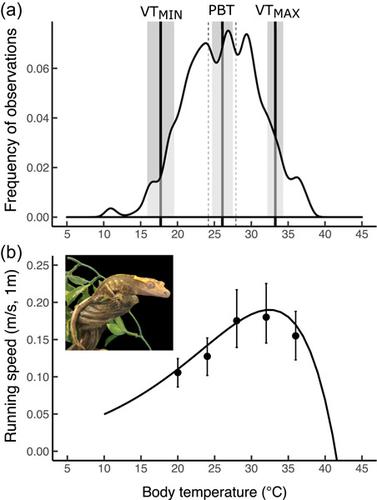当前位置:
X-MOL 学术
›
J. Exp. Zool. Part A
›
论文详情
Our official English website, www.x-mol.net, welcomes your feedback! (Note: you will need to create a separate account there.)
Thermoregulation and thermal performance of crested geckos (Correlophus ciliatus) suggest an extended optimality hypothesis for the evolution of thermoregulatory set‐points
Journal of Experimental Zoology Part A ( IF 2.8 ) Pub Date : 2020-06-01 , DOI: 10.1002/jez.2388 Andrea Aparicio Ramirez 1 , Karina Perez 1 , Rory S Telemeco 1
Journal of Experimental Zoology Part A ( IF 2.8 ) Pub Date : 2020-06-01 , DOI: 10.1002/jez.2388 Andrea Aparicio Ramirez 1 , Karina Perez 1 , Rory S Telemeco 1
Affiliation

|
Crested geckos (Correlophus ciliatus, formerly Rhacodactylus ciliatus) were rediscovered in New Caledonia 25 years ago and despite being common in the pet trade, there is no published information on their physiology. We measured thermoregulation (preferred body temperature, thermal set‐point range, and voluntary limits) and performance (thermal performance curves [TPC] for 25 cm sprint speed and 1 m running speed) of adult and juvenile crested geckos in the laboratory to describe their thermal tolerances, differences among life stages, correlations between behavior and performance, and correlations with natural temperatures. Despite lacking special lighting or heating requirements in captivity, crested geckos displayed typical thermal biology for a lizard with no difference among life stages. They thermoregulated to a narrow set‐point range (TSET, 24–28°C), that broadly overlaps natural air temperatures in New Caledonia, during activity. Somewhat surprisingly, the optimal temperature for performance (TOPT, 32°C) was substantially above preferred body temperatures and approximated the average maximum temperature voluntarily experienced (VTMAX, 33°C). Preferred body temperatures, by contrast, corresponded to the lower threshold temperature (Td) where the TPC deviated from exponential, which we suggest is the temperature where performance is optimized after accounting for the costs of metabolic demand and overheating risk. Our results demonstrate that despite their lack of specific requirements when housed in human dwellings, crested geckos actively thermoregulate to temperatures that facilitate performance, and have thermal biology typical of other nocturnal or shade‐dwelling species. Additionally, crested geckos appear at little risk of direct climate change‐induced decline because increased temperatures should allow increased activity.
中文翻译:

壁虎(Correlophus ciliatus)的温度调节和热性能为温度调节设定点的演变提出了扩展的最优假设。
凤头壁虎(Correlophus ciliatus,前身为Rhacodactylus ciliatus)是25年前在新喀里多尼亚重新发现的,尽管在宠物贸易中很常见,但尚无有关其生理学的公开信息。我们在实验室中测量了成年和少年凤头壁虎的体温调节(首选体温,热设定点范围和自愿性极限)和性能(25 cm短跑速度和1 m跑步速度的热性能曲线[TPC]),以描述它们的壁虎热耐受性,生命阶段之间的差异,行为与性能之间的关联以及与自然温度的关联。尽管缺乏人工饲养的特殊照明或加热要求,但凤头壁虎仍显示出蜥蜴的典型热生物学特性,各生命阶段之间没有差异。它们将温度调节到狭窄的设定点范围(T SET,24-28°C),在活动期间与新喀里多尼亚的自然气温大致重叠。出乎意料的是,性能的最佳温度(T OPT,32°C)大大高于优选的体温,并且接近自愿经历的平均最高温度(VT MAX,33°C)。相反,优选的体温对应于较低的阈值温度(T d)TPC偏离指数的地方,我们建议在考虑代谢需求和过热风险的成本后,性能将达到最佳温度。我们的结果表明,尽管它们居住在人类住宅中时没有特别的要求,但是凤头壁虎可以主动调节温度,以促进性能,并具有其他夜间或阴暗物种的典型热生物学特性。此外,凤头壁虎似乎很少有直接因气候变化而导致下降的风险,因为温度升高应允许活动增加。
更新日期:2020-06-01
中文翻译:

壁虎(Correlophus ciliatus)的温度调节和热性能为温度调节设定点的演变提出了扩展的最优假设。
凤头壁虎(Correlophus ciliatus,前身为Rhacodactylus ciliatus)是25年前在新喀里多尼亚重新发现的,尽管在宠物贸易中很常见,但尚无有关其生理学的公开信息。我们在实验室中测量了成年和少年凤头壁虎的体温调节(首选体温,热设定点范围和自愿性极限)和性能(25 cm短跑速度和1 m跑步速度的热性能曲线[TPC]),以描述它们的壁虎热耐受性,生命阶段之间的差异,行为与性能之间的关联以及与自然温度的关联。尽管缺乏人工饲养的特殊照明或加热要求,但凤头壁虎仍显示出蜥蜴的典型热生物学特性,各生命阶段之间没有差异。它们将温度调节到狭窄的设定点范围(T SET,24-28°C),在活动期间与新喀里多尼亚的自然气温大致重叠。出乎意料的是,性能的最佳温度(T OPT,32°C)大大高于优选的体温,并且接近自愿经历的平均最高温度(VT MAX,33°C)。相反,优选的体温对应于较低的阈值温度(T d)TPC偏离指数的地方,我们建议在考虑代谢需求和过热风险的成本后,性能将达到最佳温度。我们的结果表明,尽管它们居住在人类住宅中时没有特别的要求,但是凤头壁虎可以主动调节温度,以促进性能,并具有其他夜间或阴暗物种的典型热生物学特性。此外,凤头壁虎似乎很少有直接因气候变化而导致下降的风险,因为温度升高应允许活动增加。


























 京公网安备 11010802027423号
京公网安备 11010802027423号